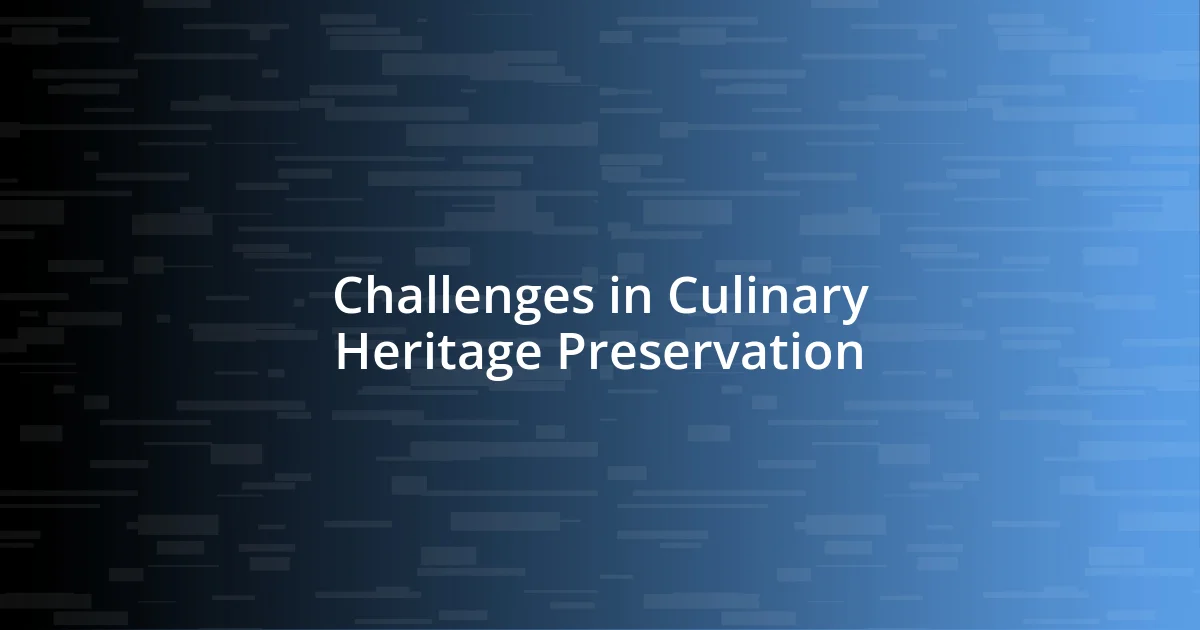Key takeaways:
- Culinary heritage is a vital part of cultural identity, connecting communities through tradition and shared meals.
- Preservation faces challenges such as globalization, fading techniques, and economic viability for small-scale producers.
- Engaging families and communities in preserving traditions through cooking and storytelling fosters deeper connections to culinary history and identity.

Understanding Culinary Heritage Importance
Culinary heritage is far more than just recipes passed down through generations; it’s a vibrant tapestry of culture, history, and identity. I remember my grandmother patiently teaching me how to roll out dough for her famous pastry. Each fold felt like unlocking a family secret, connecting me to our roots in a way that mere words could never achieve. Isn’t it fascinating how a simple dish can hold such profound memories and meanings?
Engaging with culinary heritage allows us to celebrate diversity in flavors and cooking techniques that define communities. When I travel, I make it a point to learn local dishes, not just to satisfy my palate but to connect with the people and their stories. Don’t you find that the meals we share can spark conversations that bridge gaps between different cultures and generations?
Moreover, preserving culinary heritage is crucial for promoting sustainability and biodiversity. I’ve seen firsthand how traditional farming practices bring forth unique ingredients that are often overlooked in modern diets. Shouldn’t we strive to keep these practices alive, ensuring that future generations can savor the same rich flavors and stories that have shaped our world?

Challenges in Culinary Heritage Preservation
Culinary heritage preservation faces numerous challenges, one of which is the rapid globalization of food culture. I’ve noticed that traditional recipes often get overshadowed by fast food chains and convenience foods. It’s disheartening when a beloved family dish is replaced by a quick meal that lacks the rich history of its origins. How often do we pick a quick bite over a lovingly prepared feast that tells a story?
Another challenge is the fading knowledge of traditional cooking techniques. I remember the first time I tried to replicate a recipe from an old family cookbook. It was frustrating, as I realized that some of the techniques I overlooked were crucial to getting the flavors right. These skills, often passed down orally, are at risk of disappearing as fewer people engage with them. Isn’t it sad to think that so many culinary methods could vanish simply because subsequent generations prioritize convenience?
Furthermore, the economic viability of preserving culinary heritage can be tough. Small-scale farmers and producers often struggle against larger corporations, which can push traditional ingredients and practices to the sidelines. I have witnessed farmers who grow ancient grains losing market share to mass-production agriculture. It raises the question—how do we support these stewards of our culinary history while maintaining good business practices?
| Challenge | Description |
|---|---|
| Globalization | Traditional recipes are overshadowed by fast food and convenience options. |
| Fading Techniques | Many traditional cooking skills are at risk of disappearing. |
| Economic Viability | Small-scale farmers struggle against larger corporations. |

Role of Families in Preservation
Families play a crucial role in the preservation of culinary heritage, serving as the primary transmitters of recipes and cooking techniques. I cherish the moments spent in my kitchen, where my parents would gather around, sharing stories as they reconstructed our family’s traditional dishes. These shared experiences not only foster a sense of identity but also weave a stronger familial bond.
- Recipe Sharing: Family members pass down cherished recipes, often accompanied by stories that enrich the cooking experience.
- Skills Transfer: Each generation teaches the next, ensuring essential cooking techniques aren’t lost, much like how I learned the art of fermenting from my father.
- Cultural Identity: Families instill a sense of belonging by celebrating traditional meals during holidays, reminding us of our unique cultural roots.
It’s fascinating how attempting to replicate my mother’s Sunday sauce became more than a cooking lesson; it turned into a heartwarming journey where she shared anecdotes of my great-grandparents preparing the same dish. Each step in the process felt sacred, highlighting the importance of not just the food itself, but the shared history behind it. Engaging with culinary heritage in this way is an intimate act of love that reinforces our family’s stories and traditions, stitching us closer together through flavors and memories that are deeply rooted in our identity.

Community Initiatives for Heritage
Community initiatives dedicated to preserving culinary heritage can have a transformative impact. I recently volunteered at a local food festival that highlighted traditional recipes from various cultures. It was heartwarming to see families come together, sharing dishes that had been passed down through generations. Isn’t it beautiful how food can connect us in such profound ways, reminding us of our roots while introducing others to vibrant cultures?
One initiative that struck me was a cooking class organized by a community center, where older generations taught their traditional dishes to younger participants. I watched as older ladies shared their secrets for making homemade pasta, their laughter filling the room as they reminisced about their own grandmothers. This kind of hands-on experience not only preserves culinary techniques but also nurtures relationships and fosters mutual respect among generations. What better way to honor our heritage than by physically engaging with it, don’t you think?
Moreover, I’ve seen local farmer’s markets play a pivotal role in sustaining culinary traditions. When I visited one last summer, I was drawn to a stall selling heirloom vegetables that have been grown using ancient methods. The farmer was eager to share the story about each variety and how they contributed to traditional dishes. It’s eye-opening to realize that by supporting these local initiatives, we’re not just buying food—we’re investing in the preservation of our culinary heritage and the stories attached to it. Isn’t it empowering to know that our choices can directly impact the culinary stories of tomorrow?

Documenting Traditional Recipes Effectively
Documenting traditional recipes effectively goes beyond merely writing down ingredients and instructions; it’s about capturing the essence of the dish. I often jot down not just the measurements but also the sensory details—the aroma wafting from the pot, the sound of sizzling, and even the emotional connection I feel while cooking. When I share these notes, I invite others into my cherished memories surrounding each recipe.
One method I’ve found particularly effective is recording oral histories. I remember sitting with my grandmother, listening to her recount how she learned to make her famous tamales as a young girl. We recorded her voice, not just for accuracy but to capture her laughter and the pride in her storytelling. It transformed simple documentation into a living archive, showcasing the heart behind the recipe. Isn’t it amazing how a recipe can hold stories that span generations?
Additionally, creating a visual element is invaluable. I often take photos of the cooking process—from chopping ingredients to the final plated dish. These images become a visual index that not only serves as a lovely reminder of the cooking journey but also helps others recreate the recipes authentically. Adding these layers elevates the process; it’s not just about preserving food but preserving the very essence of who we are through our culinary traditions. How do you think imagery can deepen our connection to family recipes?

Modern Adaptations of Traditional Dishes
I’ve noticed that many chefs are reimagining traditional dishes by merging them with modern culinary trends. I remember visiting a trendy restaurant where they served a deconstructed version of my grandmother’s classic shepherd’s pie. It was fascinating to see the flavors I grew up with presented in a new and exciting way, almost like a culinary homage. Have you ever tried a dish that brought back memories while showcasing a contemporary twist?
Another aspect of modern adaptations is the introduction of healthier ingredients to beloved recipes. For instance, I once experimented with my mother’s potato latkes using sweet potatoes instead of regular potatoes. The result was not only a delightful change in flavor but also a boost in nutrition, while still evoking that same comforting nostalgia I associate with family gatherings. Isn’t it wonderful when tradition can evolve to meet our health needs?
Finally, I’ve come across several food bloggers who dedicate their platforms to fusion cuisine, blending traditional recipes from different cultures. One of my favorites is a fusion taco that combines elements of Vietnamese banh mi with classic Mexican flavors. It embodies the idea that culinary heritage is not stagnant; it’s alive and continually influenced by our experiences, travels, and even friendships. Have you experienced a dish that beautifully melded different traditions? It can be a reminder that innovation doesn’t erase tradition; rather, it can celebrate and elevate it.

Promoting Culinary Heritage Globally
Promoting culinary heritage on a global scale requires a nuanced approach that embraces both tradition and innovation. I remember attending a cultural festival where local chefs showcased their family recipes alongside international versions. It was incredible to see people share their culinary stories, creating connections through taste. Isn’t it powerful how food can bridge cultural divides?
Social media plays a pivotal role in promoting culinary heritage today. I’ve seen talented home cooks and professional chefs alike use platforms like Instagram to share not just recipes, but also the narratives that accompany them. Once, I shared a video of my mother’s bánh xèo sizzling on the stovetop and the comments flooded in, with friends sharing their interpretations and memories. How can we harness this global platform to foster appreciation for diverse culinary traditions?
Community initiatives also serve as crucial touchpoints for culinary heritage preservation. I recall participating in a cooking class where we learned to make traditional Italian pasta from a local nonna. The experience was a deep dive into her family’s history as she recounted stories while rolling out dough. This hands-on approach not only preserved those recipes but also ignited a passion in participants to carry on these traditions. In what ways do you think personal experiences like these can ignite a broader interest in culinary heritage?














